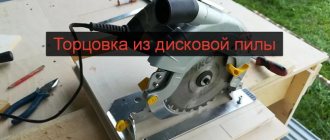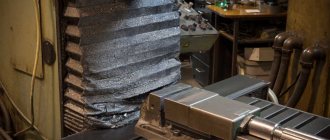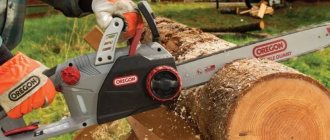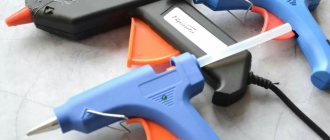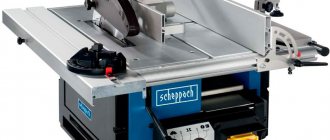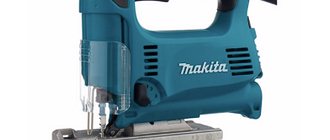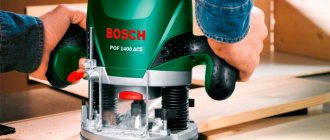Main selection criteria
Before you start choosing a miter saw, you need to know which design elements and parameters you should pay priority attention to. Let us consider the main criteria for choosing a good “trimming” in more detail.
engine's type
Modern pendulum saws can use three types of electric motors. Each design solution has its pros and cons:
- Asynchronous motor. It is distinguished by reliability, efficiency and low noise level. However, this solution also has one serious drawback: low power and rotor speed with significant weight. This is why most manufacturers do not equip household models with asynchronous power plants;
- Commutator motor. It has an ideal ratio of power to weight and size indicators. Such power plants have a simpler control system and speed stabilization. The rotational speed of the commutator motor shaft can easily exceed 10 thousand rpm. There were some drawbacks: limited brush life, high noise levels, overheating of the armature windings under increased loads;
- Brushless motor. It is a kind of symbiosis of collector and asynchronous technology. In such a motor, the weakest link, which is the brushes, is replaced with an electronic unit. Such power plants incorporate all the advantages of classical technologies: high power with low weight, noiselessness, low maintenance, high reliability. The only drawback of crosscut saws with a brushless motor is their high cost, which is more than compensated by the long service life of the tool.
Asynchronous motor Brushless motor
Gearbox type
When choosing a suitable miter saw, you should definitely pay attention to the design of the gearbox - the second most important element of the cutting unit of any miter saw. This element is the connecting link between the power unit and the saw blade. This tool uses two types of gearboxes:
- with gear transmission;
- belt drive.
Miter saw with gear drive Miter saw with belt drive
The toothed gears of the gearbox are reliable and durable. They transmit torque from the motor rotor to the saw blade spindle without slipping. However, if the gear fails (tooth breakage due to excessive load), the entire gearbox will need to be replaced, or an expensive repair of this unit will be required.
Belt drive also has a lot of disadvantages: it is possible for the belt to slip on the shafts and wear out quite quickly due to the high coefficient of friction. However, manufacturers of pendulum saws widely use belt gearboxes in their products. Thanks to this design, manufacturers were able to reduce bearing wear caused by vibration, which is partially smoothed out by the belt drive. A belt that has fallen off is easy to put back in place; you can simply replace it yourself if it becomes critically worn. In addition, when the disk jams, the belt will slip on the shafts, which will save the motor windings from overheating and expensive components from destruction.
Saw blades
When answering the question of which model of miter saw is best to buy, you should decide on its purpose and operating conditions. In other words, any disc will do for working with wood. If you intend to use trimming for processing various materials, a very important point is the correctly selected equipment, which varies:
- Outer diameter. Depending on the model, saw blades with a diameter of 210, 250 and 305 mm can be used in cross-cutting machines. Circles of smaller and larger diameters are quite rare, since they are intended for specialized equipment, which is extremely rarely available for sale;
- A landing hole, the diameter of which can be 25 or 30 mm;
- Material.
Saw boards can be monolithic or carbide. The first ones are made of high-carbon steel, which tends to “shrink” quickly. You can sharpen such a disc yourself without using specialized equipment. The carbide cutting tool is equipped with pobedit tips that hold an edge perfectly; Monolithic (left) and carbide (right) disc
What to look for when purchasing
To independently choose a miter saw, you need to formulate the same questions for yourself as for a consultant in a store.
In addition, it is important not to lose sight of the following criteria:
- Purpose of purchasing the tool. For occasional work in the home workshop, you can be satisfied with a locally produced entry-level model with a standard set of options. For professional work with large volumes, you will need a more advanced tool, equipped for those types of work that will be performed most often.
- Work safety. Make sure that the protective cover of the working disk is securely fastened and easily moved, that the power cable is sufficiently long, and that the power button latch operates reliably.
- The weight and dimensions should be within your range and ensure long-term work without fatigue.
- Ergonomics. The saw should be easy to use, fit well in the hand, and not require unnecessary movements or awkward postures when working.
The depth and width of the cut are the key characteristics that determine the list of materials available for cutting on this model and the maximum dimensions of the workpieces processed.
Disc diameter. Landing hole. Sharpening angle
The diameters of saw blades for most miter saws range from 165 to 355 mm . The larger the blade, the greater the depth of cut the saw has. By the diameter of the equipment you can immediately judge the power and class of the power tool. When choosing a trimmer, the maximum disk size is correlated with the amount of work that is planned to be performed. This allows you to optimize time costs and reduce tool wear. The dimensions of the entire tool are directly related to the size of the disk: the larger it is, the more massive the support platform, the larger and higher the saw unit.
The gold standard for saw blades for household and semi-professional miter cuts is 190-210 mm. Professional tools are equipped with accessories with a diameter of 250-305 mm or more.
Disc mounting diameter. The diameter of the mounting hole for most disks is from 16 to 30 mm . In some cases, the problem of equipment that does not fit the spindle can be solved with the help of an adapter. Using blades that do not fit the saw's fastening parts may cause wobble during rotation and loss of control of the tool.
Sharpening angle . Saw blade teeth have a positive or negative rake angle. For cross-cutting sliders - saws with broaching, which we will talk about below - select discs whose teeth have a negative rake angle. Saws without broaching work better with equipment that has a positive angle. Of course, any saw blade will work on every type of trim, but following the described nuances will ensure the cleanest and most accurate cut possible.
How to choose the right trimmer
How to choose a miter saw so that
- Don't regret it.
- Don't overpay.
Sales consultants on the sales floor know everything about the products presented to them. However, so that the buying process does not turn into a monotonous monologue of a consultant and the suppressed silence of the buyer, who ends up taking away with him a model twice as powerful and three times more expensive than he could actually afford, the buyer needs to have a clear idea of
- why does he need a saw;
- what operations he plans to perform on it most often;
- what are the maximum dimensions of workpieces;
- what volume of work is planned per month?
Clear answers to these questions, firstly, will inspire the consultant with minimal respect, and, secondly, will allow you to narrow the range of models under consideration to reasonable limits. But even within this narrowed list, the range of prices and additional features will be great. At this stage, the buyer must decide
- does he need a laser pointer (in fact, he always needs it. The time for cutting “by eye” is over.);
- Do you need an electronic adjustment system with memory?
- Is a pulling system needed?
If a miter saw is purchased for occasional work, such as making a frame for a greenhouse or a garden gate, there is no need to splurge on a high-performance professional unit from a well-known brand with an extended base, electronic settings, controlled broaching and other improvements.
Such a saw will be needed if the buyer plans to open his own woodworking business and already has a sufficient volume of orders of medium and high complexity. In this case, a professional device will save time and quickly pay for itself.
With or without broaching?
To create longer cuts, choose models with a broach, also known as miter-sliders, in which the saw unit not only lowers down and turns to the sides, but also moves in a horizontal plane - forward and backward. In addition to the increased cutting width, broached crosscuts provide a number of additional benefits, such as allowing double cuts to be made in one pass.
Crosscuts without broaching, despite their seeming obsolescence, are no less popular. The ratio of sliders and conventional miter saws on the power tool market is about 60 to 40 - this is a rather rough statistic, which, however, clearly shows that old-type systems are not going to lose their positions.
Limitations in cutting length are compensated by the stability of adjustments and reliability of the system, which are achieved thanks to a simplified design and fewer moving parts. Models without broaching are much lighter - the difference in weight is 25-50% - this is a strong argument if the machine is often moved or transported to different sites. And finally, the price issue, in which everything is obvious - miter saws without broaching cost an order of magnitude less than saws of the same class, but with broaching.
For saws of different classes, discs with different rake angles are used, as we discussed above. For sliders, discs are selected whose teeth have a negative rake angle. For saws without broaching, use blades with a positive angle.
In many slider models, the saw unit moves back and forth along guides that require a minimum of 30-40 cm of free space from the wall. If there is a sawdust bag at the back, you will need even more space. In a small workshop, placing such a trim can be a difficult task.
In modern models, developers have successfully solved this problem. For example, in Boshev's Glide family of crosscut saws, the saw unit moves not along guides, but with the help of a hinge-lever mechanism. Festool uses an even more beautiful engineering solution in its KAPEX KS 60 saws: the guide rods are turned towards the operator and do not protrude beyond the body during broaching.
Horizontal and vertical cutting capabilities
Modern crosscut saws allow you to make combined cuts. The saw blade of the tool can be rotated not only to the right or left to cut the workpiece at the desired angle in the horizontal plane, but also tilted to one or both sides, thereby providing a vertical cut. The horizontal and vertical cutting capabilities of modern miter saws are different, so let’s briefly talk about what you should pay attention to when choosing a saw based on these parameters.
- One-way and two-way tilt . The miter saw unit can tilt in one or both directions. In terms of functionality, both options are the same: with single-sided models you can perform the same sawing operations as with double-sided models. But in matters of convenience, the latter unconditionally win. To cut each end of the board on a single-sided saw, the workpiece must be removed from the bed, turned over and re-fixed. Such juggling becomes a separate challenge when you have to work with long and heavy workpieces in large volumes. Tilt in both directions - saves time and effort.
- Max cutting depth at an angle of 45° . In modern models this figure varies from 25 to 122 mm . At an angle, the miter cut does not cut as deeply as in the 90° position. Machines with a shallow corner cut depth are an option for those who plan to work with lining, laminate and other thin materials. For all other cases, it is important to prudently compare this parameter with what will primarily have to be cut. This will avoid the most common disappointment when it turns out that the tool is not able to cope with facing thick workpieces at an angle. It is also important to remember that miter sawing creates greater loads on the tool - the higher the power, the better the quality of the cut the trim provides.
- Max cutting depth at 90 ° angle. For non-industrial miter saws, this figure ranges from 45 to 122 mm. Placing the saw assembly perpendicular to the workpiece surface is the most common configuration in which most sawing operations are performed. Therefore, special attention should be paid to choosing a machine for this parameter. The greater the depth of the straight cut, the higher the class of equipment.
- Max cutting width at an angle of 90° . A parameter that reflects the maximum width of the workpiece that can be cut by the miter saw at a right angle. In modern household and professional saws this figure varies from 85 to 430 mm. In general, this is one of the key indicators that determine the productivity of the machine. It is important not to forget that the cutting width at 45° will be significantly smaller than at a right angle.
Number of revolutions
The number of revolutions, or idle speed, is another important characteristic that determines the effectiveness of the tool. For different models, this figure ranges from 3200 to 6000 rpm. The higher the idle speed, the better the cut the miter saw produces.
Professional category models have a speed control function. It makes sense to pay attention to it first of all for cabinetmakers and everyone who uses a trim for carpentry needs. Adjusting the speed of the saw blade allows you to adjust the sawing process to the characteristics of a specific material: different types of wood, chipboard, etc. During “stream” sawing, they operate at high speeds, achieving greater speed and productivity. By lowering the speed, you gain greater control over the sawing, which is important when cutting critical parts.
Main technical characteristics
For any electrical tool and technological equipment, the main indicators of use are the declared technical characteristics. For miter saws they are:
- Electric power. One of the important characteristics that determines performance is the permissible diameter of saw blades, as well as overall dimensions and weight.
- Spindle speed. The cleanliness of the cut of the workpiece being processed depends on this parameter.
- Diameter of the disk used. This characteristic is based on the design features of the device, which determine this parameter both by the dimensions of the housing and the power of the electric motor. On household models, as a rule, discs with an outer diameter of 250 mm and a seat diameter of 30 mm are used; for professional equipment, the outer diameter may be larger.
- The width of the cut depends on the size of the saw blade, determined by the design of the particular model.
- Cut parameters. This indicator depends on the diameter of the saw blade, as well as the presence of a broaching function, which allows processing wide workpieces, which is achieved by the presence of a special stand and a mechanism for feeding the disk along the cutting line.
- Engine's type. Equipment of this type is equipped with two types of electric motors (asynchronous and commutator), which differ in the frequency of maintenance and warranty periods.
- Type of transmission. The devices under consideration can be equipped with a gear or belt drive. The second option is used on permanently installed models and has a low noise level, but requires belt tension control. The gear drive is reliable in use and eliminates the possibility of slippage during operation, but is characterized by an increased noise level and the possibility of vibration.
- Rotary system parameters. These characteristics are determined by the capabilities of the rotary table and the stops available on it.
- Security systems. Safety systems on such devices ensure that the electric motor is turned off if it overheats or the saw blade jams, provides smooth start-up and locking when replacing the blade, as well as protection against short-circuit currents and rigid fixation of the workpieces being processed.
- Additional options. This category may offer functions such as illumination of the working area and a laser pointer, limiting the depth of cut and maintaining a given saw blade speed under load.
The higher the electrical power, the greater the weight of the miter saw, as well as its cost.
The presence of a laser pointer simplifies the execution of intended operations
Additional options
Companies that produce end plates compete to provide their products with the maximum number of additional options. Some of these options are aimed at increasing safety, others at increasing productivity and developing new functions, and others at improving working conditions and ease of use.
Lighting the cutting area
Options such as:
- Lighting the cutting area.
- Speed maintenance system.
- Cutting depth limiters, allowing you to make grooves.
- Laser level indicator.
have become a de facto standard and are included in the equipment of almost every model.
Miter saw stand
A useful option at the top of the product line is a sturdy stand onto which the saw is mounted. With this addition, you don’t need to worry about mounting it on a workbench or making a separate desktop
The nuances of making miter saws with your own hands
If you have free time, the ability to work with various types of equipment and tools, and most importantly, if you have the desire, you can make a miter saw yourself. In this case, you need to know the main nuances that need to be taken into account when performing work, namely:
- a miter saw is a traumatic tool, therefore, without a protective casing and reliable fastening elements, devices of this type cannot be put into operation;
- the working surface on which the workpiece will be moved must be flat;
- for an emergency stop of the saw, a special button or shutdown switch must be provided;
- the materials and equipment used must be in good condition and technically sound.
Option for making a crosscut using a hand-held circular saw
There can be a large number of options for making wood trim; such a design depends on the available materials and spare parts. In this video you can get acquainted with the sequence of actions for making a tool yourself.
Functions of hybrid models
Hybrid models are saws equipped with an additional work table with longitudinal guides, into which a removable circular saw is attached from below, and the blade goes into a groove on the table.
Hybrid miter saw model
We must be aware that this device will not be able to alternately unravel the boards and process their ends. With each change of operation, you will have to rearrange the saw and change the disk, carry out adjustments and set the initial coordinates.
This option is not acceptable for large volumes of sawing. In this case, it would be more appropriate to purchase two specialized units, each of which will be well-debugged and will be able to work with the proper accuracy and performance.
However, for an amateur craftsman who is not burdened with large production volumes and has limited funds, a hybrid model may be a good solution, especially for the first time.
